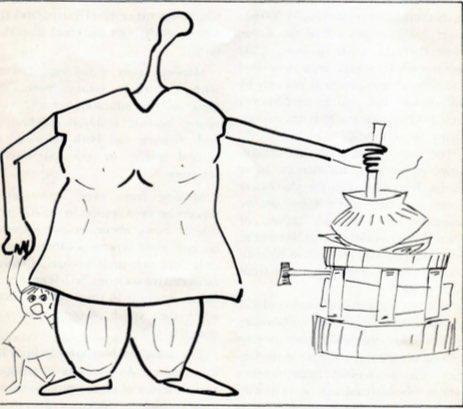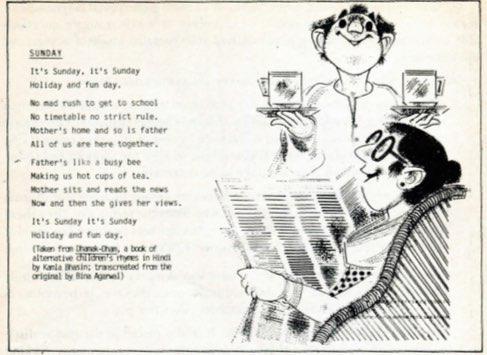(Sri Lanka)

School text books are a potent means of perpetuating stereotyped images of women and anti-feminine prejudices. We feel that an analysis of text books used in the various countries of the region will reveal the truth of this statement. In this article we summarise the results of two surveys — in France and in Japan — in the hope that women's groups throughout the region will begin to look critically at the text books their children are forced to use and will thereafter lobby effectively to secure changes.
Madame Francoise Giroud, when Secretary of State with special responsibility for the Status of Women, commissioned a survey in 1974 to investigate 'questionable stereotypes which might give an outdated or disparaging image of women and domestic life'.
Some of the facts revealed by this survey are summarised below:
Women are described in such a way as to show them as always weaker than men. In a modern setting, women are shown as being incapable of mastering mechanical devices — women drivers are figures of fun: they cause traffic jams and are accident-prone. Women turn to men for support and assistance, without which they would be quite defenceless.
Women are, above all, shown as mothers and, among humans and animals alike, the mother is essentially the one who feeds the young and gives them their basic education. Generally speaking, the mothers portrayed are good at teaching their children, but they teach only skills such as sewing and ironing.
Grandmothers are presented in the same way as mothers; they do the family cooking and do everyday jobs about the house or on the farm. If the mother is away or is dead, then the eldest daughter takes her place.
Marriage is given an important place. It is also placed in the non-realistic context of animal stories and fairy tales and this is given the status of a kind of sacrosanct and universal myth.
Marriage is shown as a kind of two-way arrangement in which males are on the look-out for beauty and youth and offer in exchange strength, skills, riches or royalty. The female looks for security and wants to be provided for, and will accept only the best, the handsomest, the richest or the strongest; in exchange she offers her beauty and her youth, which she shows off to the best advantage. Feelings are seldom shown as influencing the choice of a partner.
A clear distinction is made between the roles of husband and wife, both of whom are shown engaging in stereotyped activities, arbitrarily presented as universal; in every country and every situation mother prepares the food and looks after the children while father goes hunting or out to work. Scenes where the mother is shown knitting while the father reads and the children play, drive home the point that a woman's place is in the home.
Women live in comfortably appointed homes with many household appliances. What we see is the image of an urban middle-class society in which the housewife is surrounded by every material comfort.
Women are rarely shown at work and even then they are shown as teachers, nurses or saleswomen; they are never shown producing anything.
Women's social life seems to be restricted to shopping.

Even on holidays or on excursions, women still do the cooking while men go off hunting and fishing, climbing or skiing. Women appear to relax only at the seaside.
In the modern world, whose values tend to be economic ones, the text book image of a woman is one of well-fed contentment; she receives gifts, buys clothes and fills shopping bags but nowhere is she shown doing anything productive.
We wish to place, side by side with this survey, a study of Japanese picture books for children. This study was carried out by a women's consciousness-raising group in Japan called Idobata; although the members of the group come from different work-areas such as teaching, mass-media, publishing, book-selling books, libraries, research institutes, local government etc., they have a common awareness of sexist discrimination in their jobs, at home, in male-female relationships and the many other aspects of society. They are also imbued with a desire to change this situation.
Their motive for a study of picture books for children is formulated thus:
Women are constantly subject to sexism; many women are not only unaware of this, but take it for granted, or even support it as the key to their happiness. This forces us to confront the impact of culture as a whole. Education begins from the moment a child is born, a process conforming to sexist social norms which are more heavily imposed upon girls than boys.
One important means of this kind of education is picture books for young children. Picture books undeniably serve as one of the quickest and most effective tools to implant in the minds of children the values of the society to which they belong, and thus have a great influence, directly and indirectly, in forming their personalities. It was in this context that we decided to make a study of picture books and see how they are imbued with sexism. We also thought that this work of evaluation would help us to know ourselves better — our concepts, our values and the norms which dominate us.
The methodology they followed will also be of interest to other women's groups. They first selected 132 books, published in 1973 and 1974, favourably reviewed or recommended by the major review media of children's books in the country. They then proceeded to work in the following way:
First stage: Four groups, each of five to six persons, were set up, each group covering a quarter of the titles subject to the study. They first checked the books for the gender of authors and illustrators; thereafter they analysed the central figures in the stories and the adult characters for their jobs, their domestic roles, behaviour patterns, their clothes, playthings, accessories, etc. Each group read all the titles assigned to them, making careful observations.
Second stage: The four groups met together, reporting about their respective findings, followed by a question and answer period and discussion.
Third stage: Based on the results obtained at the second stage, each group continued its work, making revaluations and additions.
Fourth stage: Preparations of a report, discussing the book on the following criteria: 1. Sex roles (or sexual division of labour). 2. Masculinity and femininity. 3. Mother roles. 4. Women's occupations.
Their findings and conclusions can be briefly set out as follows:
- Sex Roles: It seems that the most common way of representing a father is to have him reading the paper and/or smoking a cigarette. In contrast, none of the 132 titles showed a mother reading a paper... the depiction of a father who does none of the household work, and a mother who devotes herself to housekeeping and taking care of her children during all her waking hours beautifully conveys to reader-children the traditional concept of mother-father roles, that dichotomy of man outside and woman inside. . . . An image of women as social beings has never been written or conceived as a theme by authors, unfortunately including female ones. Women in books have always been and still are, confined to biological and domestic roles, a situation which totally ignores the fact that women are active in various fields.
- Masculinity and Femininity: Sexual traits are very stereotypically presented — boys as active, teasing and protecting the girls, kicking a ball, offering a flower to the girl, giving her a ride on the bicycle — all traits traditionally regarded as masculine; the girls as passive — teased and protected by the boys, pleased with the flower, receiving a ride — all well-established feminine characteristics. ... It is almost invariably boys, not girls, who chance on clever, interesting ideas and proceed to act on them, or find problems and fight for a way out, or have a dream and work hard to make it come true. What we cannot overlook in almost all books for children, are the assumptions on which they stand, that is, male-active, positive, inventive, creative, etc., and female-static, passive, helpful to others, especially males, acting as a mere accessory to the male, watching and following his actions.
- Mother's Role: Because of that dichotomy of man outside and woman inside, in most cases it is women who appear in relation to children and stories rarely tell of father-child relationships ... with the changing times, the roles of mothers, of women, are also changing. But book makers — authors, artists, editors and publishers — are ignoring this reality by placing books on the market based on the firm belief that it is best for mothers to raise their own children, affirming the traditional concept that women's roles are defined as housekeeping and raising children. ... There are hundreds and thousands of examples of mothers who are working outside the home, leaving their children at day care centres or making use of after-school day centres; also women, married or unmarried who are active in citizen's movements or in various occupational fields. ... How long do we have to wait to see children's books which reflect this image of strong struggling women?
- Women's Occupations: Very few women's jobs are represented in these books...most are merely extensions of what traditionally have been considered women's roles.
In conclusion, the group says:
Sexism still strongly prevails in all aspects of Japanese life, and children's books are no exception. People generally tend to believe that childhood is something neutral, something idyllic, something free from any values and that consequently, so are children's books. But this is definitely not so. Contrary to adults' expectations, a child's world is a mirror image of the value system of the adult world. Our study reveals — we must say this with great regret — that there are very few, almost no, picture books which are free from any sexist values.
We believe that children's books all over this region would provide a similar picture and would probably lead to the same conclusion. We call upon women's groups to look at this problem carefully and determine how to fight this pervasive influence in their own contexts.
This feature appeared originally in Voice of Women, Sri Lanka.

